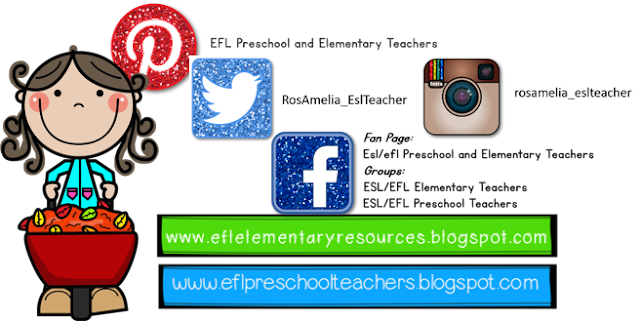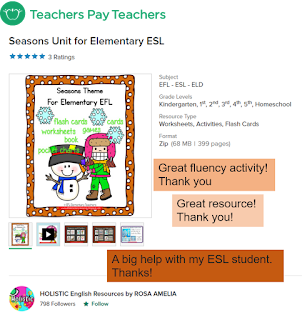In many books it is under the label of Seasonal Activities. This is the last blog post related to the Seasons Unit. I have posted Seasons and Months, Seasons and Weather, Seasons and Clothes, Seasons and Nature. Just continue scrolling the blog posts to check them out! Everything is under one product:
There are many verbs related to each Season. First, here are the flashcards.
Sort the Flashcards into
Seasons on the blackboard.
Teacher:
What season is this?
Students:
It is Winter.
Teacher:
What is he doing?
Students:
He is building a snowman.
Place each Season
Flashcard on the blackboard. Have the students look into all the flashcards and
find the Activities(Verbs) that can be done in each Season.
Teacher:
What season is this?
Students:
It is Fall.
Teacher:
What do we do in the Fall?
Students:
Play with the leaves, sit on the pumpkins, rake the leaves, and walk.
Do
the same with the other Seasons.
You can use many Verb Tenses with the flashcards. Start with CAN. Use the flashcards to model
questions and sentences on the board.
Or
model Present Continuous.
Or
you can introduce the simple past tense questions.
Maybe
you can review the future.
As
in all the Seasons Units, there is a Sorting Worksheet.
And just two worksheets.
Students complete the
worksheet. Then have them cut each picture and glue next to the sentences on
their notebooks.
The
other worksheet will be
used as a BINGO template
as well. Using either the colored flashcards placed on the board or the small
cards used for the sorting, students write the activities that can be done and
the ones that can’t be done in each Season, completing the worksheet in an allotted
amount of time, maybe 5 minutes. Some students will have more verbs than
others, but that is the idea. Then, announce the BINGO! Use the colored
flashcards to call the Verbs. The students will cross out the verb word if they
have it written down. The winner is the first one to cross out all the words.
Follow
me! Leave your comments and requests!



















































